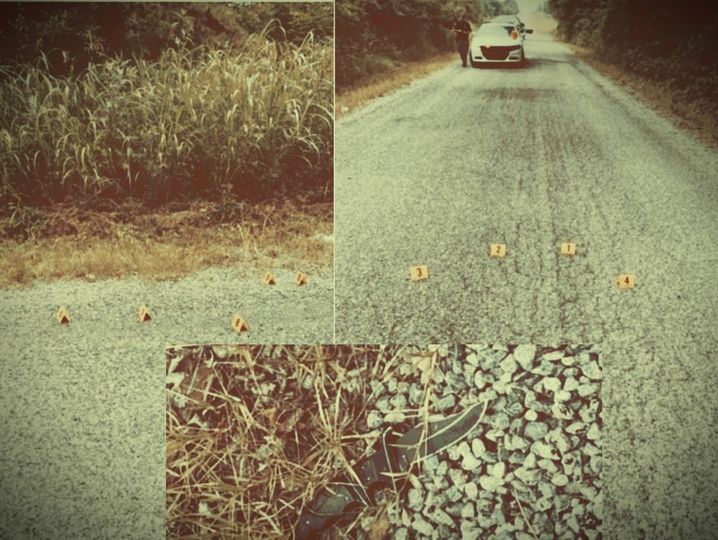
09 Feb A TRAGEDY WRAPPED INSIDE A CATASTROPHE INSIDE A DISASTER: The Story of the Prosecution and Trial of Bryce Miller PART III
TRIPPING ON A HOLE
The hours of audio were eye-opening to say the least, and so was that interview that started the whole thing. First of all, you have to remember that we are talking about a child, Jane was legally a minor. She came to the District Attorney’s office that day accompanied by her parents. I was not shocked that this young lady was used by the DA’s office, that is certainly not out of the ordinary when it comes to things, I’ve seen the government do under the guise of “seeking justice”. The fact that her Uncle was the lead investigator and nobody seemed to think that was a conflict of interest is one thing, but this young lady was used in ways I have never seen in all the years I have practiced criminal law.
For an hour and forty-two minutes Ms. Hastings-Hughes questioned Jane about her knowledge of Bryce, Jaylen, and what might have happened that night. Well to say she “questioned” Jane would be inaccurate, I heard more manipulation, confrontation and leading more than anything. On multiple occasions Jane would corroborate Bryce’s story, she would state that she believed Bryce would have only acted in self-defense. But the prosecutor kept pushing. Hastings-Hughes would make implications that Bryce shot Jaylen intentionally, and when Jane continued to resist, she just came right out and told the minor that Bryce was a cold-blooded killer, and insisted that she cooperate with the state. Ms. Hastings-Hughes suggests to the minor at one point that maybe she would be more comfortable if her parents left the room. The scariest part about that is the fact that she began the interview with Jane by reading Jane her rights in accordance with Miranda, just as you would before you interviewed someone you plan charge with a crime.
The prosecutor would play the young girl with what I felt was paper-thin compliments about how pretty she was, and how she was going places. All of this would eventually end at the same place, trying to talk this child, now without her parents in the room, into changing her position and supporting the State’s theory that Bryce Miller shot Jaylen Nelson in cold blood. The State further theorized that Bryce did this because he was in love with Jane and he was avenging her honor when Jaylen threatened her. The prosecutor kept the young girl talking, she got her to take out her phone and let her read messages, eventually getting Jane to hand over letters and other documents, all of which would have required a warrant had the minor child who now found herself alone in a room with an investigator and a prosecutor known to require one. In my essentially the state had invited in the niece of their lead investigator, used her own words against her to build enough of a false case of Accessory to Murder, and then dispose of a witness that does not fit their narrative by threatening her to either get on board or face prosecution.
Remember when I told you that a text message conversation between Jane and Bryce included a discussion about Jaylen threatening Jane? Jane asked Bryce if he would “take care” of Jaylen. Both Bryce and Jane were adamant that this meant Bryce would talk to Jaylen and smooth things out because he was friends with both.
I believe this is ultimately supported by the fact that there is no evidence from that evening to suggest that Bryce ever planned to harm Jaylen. There was no indication of planning. It was Jaylen that randomly called Bryce just before he got off work, and wanted to meet up. The State could not produce anybody that would suggest Bryce seemed different or off that night. There were no records that would indicate that Bryce and Jane spoke that day or evening just prior to Jaylen’s death. Wouldn’t it be strange, if there was some actual plan to hurt Jaylen, wouldn’t a couple of teenage co-conspirators be chatting about it right before it happened, instead of one singular comment that can easily be taken out of context about a week before?
The text was clearly being taken out of context and Jane kept trying to tell Ms. Hughes-Hastings that, while Ms. Hughes-Hastings was getting her to hand over her cell phone without a warrant. Jane’s mother brought up the possibility of talking to an attorney before they left the room, but Ms. Hastings-Hughes told them that wasn’t a good idea. The controversy over the rest of the six-hour recording would exceed even the trial, but there were relevant things on that tape that I thought a jury should hear. The State was angry that I had the tape and had listened to it. Not only was there a great deal of information on the tape, but there were some embarrassing moments on there that folks would want to keep private, and I understood that, I never cared about any of that. When It came time to answer the Judge as to what I felt was relevant on the tape, I filed an aide to the Court, which remains a public record maintained in the Court Clerk’s office.
I mentioned five specific instances from the six-hour audio tape that I felt were relevant to the trial and gave a description of each as follows:
1) Section -2:37:00-2:44:00. Walker Stewart and Ms. Hastings-Hughes discuss how the witness (Jane) appeared to be dishonest and discuss her potential role in criminal acts.
2) Section-2:44:34-2:47:01. Again, this discussion is between Walker Stewart and Ms. Hasting-Hughes. They discuss ways to gain the witness’ cooperation through means of threat of criminal charges, and getting her to “break”.
3) Section-3:47:53-3:48:27. This is a discussion involving Randy Hass and Walker Stewart. Mr. Stewart informs Mr. Hass that “Jane” lied at her interview and Mr. Hass discusses how he has known her to be a liar her entire life.
4) Section-4:10:05-4:10:05 Present is Mr. Stewart, Ms. Hastings-Hughes, Mr. Hass, and apparently Mr. Scharn is present during this discussion at some point if not the entire time. Ms. Hastings-Hughes claims she is a witness in this case after the interview with “Jane”. She also explains to the group how she told “Jane’s” parents not to retain counsel or speak to anyone. Ms. Hastings-Hughes goes on to discuss “Jane’s” numerous inconsistent statements with Randy Hass.
That interview took place on January 8, 2020, and by the time we got to trial in March, Jane had gotten a lawyer, a deal for immunity against criminal charges that the state could bring against her, Accessory to Murder as an example. This should not come as a surprise, but Jane would have to tell the “truth” (yes, I put that in quotes for a reason) in order to keep the DA’s office from filing that criminal charge against her, throwing her in jail, which would prevent her from entering the Navy after graduation as she planned. In short, she was going to testify for the State and promote their theory that she had so adamantly denied up to this point in exchange for the government not to use its power to destroy her life.
THE TRIAL
The trial would begin on March 9th, 2020, in Courtroom One at the Pittsburg County Courthouse. The trial was presided over by Brendan Bridges. The State was represented by Michon Hastings- Hughes and Adam Scharn. I, Brecken Wagner and David Smith of Norman appeared on behalf of Bryce Miller. Bryce’s Grandmother, and his parents attended most of the trial. Unfortunately, His grandfather, Chester Miller, was too weak physically to make it to the trial, and would not survive but a few months more after its conclusion.
The first matter in a jury trial is jury selection or voir dire. This is something that everybody participates in. It begins with the judge who generally asks all of the basic informational type of questions, like “How are you employed? Are you married? Do you have children?”, and so on. Judge Bridges chose not to ask those questions, and after his otherwise short inquiry of the panel he turned it over to the state. Ms. Hastings-Hughes also did not ask those basic informational questions. By the time it was our turn to speak to the jury, David had a quite a task in front of him, because we did not know anything about this panel of people. As a result, his time before the jury was much longer than we anticipated, but we also never anticipated that neither the Judge or the state would ask these folks basic questions about their lives.
Next, would be the opening statement. It was here that I laid out our case before the jury. I told the jury that Bryce went and picked up his friend Jaylen that night and the two of them went to a place they were familiar with to smoke marijuana. I told the jury that there was nothing up to this point to indicate that there was anything wrong between the two friends. It was Jaylen that had called Bryce out that evening, not the other way around. Bryce was not taking Jaylen anywhere to kill him like the State wanted them to believe, and there was no evidence to support that idea.
What happened next was a tragedy that could result in a second tragedy. I told the jury that Bryce Miller shot Jaylen Nelson to death that night, because if he didn’t Jaylen Nelson was going to kill him. Jaylen got angry. Jaylen took out his knife, the same knife officers would find up the road, and came toward Bryce with it. I explained how the physical evidence could tell the story that witnesses would have if there had been any there. I told the jury that it was all right there in the pattern the spent shell casings had left.
The first shot happened in the ditch where both of the boys were standing. After pulling the gun from his waistband and firing, Bryce moved out of the ditch the only way he could. David and I had gone to the scene, we had stood in the same place. The surest footed, fastest and safest direction to run was forward and to the right away from Jaylen. I then told the jury that the next obvious move would be to run around the truck for safety, placing the truck between him and Jaylen. It was here that I pointed out to the jury that we know that’s exactly what Bryce did because we can follow the crescent shape pattern of where the shell casings fell. On an empty street it just looked like a pattern in an arc a few feet apart, but it was not difficult at all to imagine a vehicle sitting right there in the arc, and we know there was one parked on that roadway when the shooting happened.
Seven shell casings in all. The state wanted to portray this as overkill, because six out of the seven shots hit Jaylen. But those shots did not all occur in the same place, the person shooting was moving, and to the defense we thought that could only mean one thing, he was running. You don’t run away when you are attacking, you run away when you are afraid, Bryce Miller shot Jaylen Nelson because he was afraid.
The witnesses to come would bear this all out perfectly. David brilliantly cross-examined the officers and was able to establish how poor of an investigation they had actually done. From the first tip they had concluded that Bryce Miller had killed Jaylen Nelson in cold blood, because he ran. Neither myself or David had any issue with those facts, when you’re a sixteen-year-old kid, your run. Most of the adults that I have represented, that I know did not commit the crime they were accused of, ran. The investigators didn’t even consider looking to Jaylen as the aggressor, even after Bryce told him that he was.
Bryce was interviewed by officers, without his parents or grandparents present, in his room, as two large officers, guns on their hips, stood between him and the only exit and interrogated and accused him. Bryce told those officers that Jaylen had come at him with a knife and he felt in fear of his life and defended himself. Despite the fact that those officers corroborated his story when they found the knife and could have corroborated further if they had paid any attention to the pattern of shell casings. However, they did not. Instead, they concluded that Bryce had agreed to kill Jaylen for his friend “Jane” and he apparently executed this plan by waiting for Jaylen to call him out of the blue and want to go for a drive to a secluded area so that Bryce could kill him.
The trial was going well as we moved into the fourth day, probably to well as I look back on it. The State had rested its case and I called “Jane” to the stand. My intention was to call Jane and let her explain what she had previously told me and what she had repeatedly told the investigators and the District Attorney, prosecuting the case, Bryce had always claimed that he acted in self-defense. Instead, she said very little. She was scared. Her attorney was in the courtroom and had brokered a deal for her immunity from criminal prosecution, but that was only if she told what they said was the truth. When she was vague about how Bryce had maintained he acted in self-defense and that these theories about him killing Jaylen because he was obsessed with her were comical at best, all things she had said before, I tried to impeach her by playing her own interview with Ms. Hastings-Hughes. I wanted the jury to hear the confident and outspoken young lady that I had heard on that tape. I wanted the jury to hear Ms. Hastings-Hughes manipulate her and try to convince her that she was wrong and that Bryce was a “stone cold killer”. I asked to play the tape for the jury several times, but was denied every time by the court. I was confident that I would get to play the tape to the jury.
By now the defense knew that Jane’s testimony was not going to be what it had been up until her meeting at the DA office. She had hired an attorney, made an immunity deal, and we had been given a document that stated what “truth” she was going to testify to maintain her immunity deal. However, I believed that I would be able to get in the tape by essentially confronting Jane with her own words, and at the same time letting the jury get to meet the witness we believed Jane really was. At each attempt to play the tape I was stopped. At each attempt to set up an argument to play the tape I was stopped as well. The government objected profusely and I felt like they knew how important it would be for the jury to hear that tape too. In the end, the government was successful in keeping the tape out, and Jane’s appearance I felt was more harmful to our case than helpful. This was a very difficult turn given that I had truly felt Jane was a good witness for the defense up to that point.
When I left court that day and took the long walk up the hill to my office, I felt dejected. I was angry at myself for making a mistake, while at the same time feeling this great disappointment in our system. I felt small. I felt bullied and defeated. When you commit yourself to a career of taking on things that are always bigger than you (like some defense lawyer always standing up against the full weight and power of either the state or federal government), bad days happen. You can’t become a fighter of bullies without getting punched in the nose from time to time. The question you must ask yourself is whether you are going to sit there and fixate on the metallic taste of your own blood, or if you are going to get back up off your ass and do something. Our trial was going to end the following day and although we had just gotten punched in the nose. As I crossed the parking lot of the First Baptist Church, nearing the end of my journey from the courthouse to my office, I turned to David for guidance.
We decided to take a few minutes and go our separate ways and eat a little something. Then we would meet back up and plan our last day. We also knew we had to do something that we had not thought would be necessary up to that point, we needed Bryce to testify. I was very afraid of that. We had attempted to work with Bryce on testifying, just in case there was a chance we would need it. Those attempts had not gone well, he was so young and just ripe for a skilled attorney to frustrate, confuse and trap him, and that was something we knew could not happen. It was going to be a long night, but little did we know it was going to be the first of two very long nights.
NEXT: The close of the trial, verdict, and conclusion.



Sorry, the comment form is closed at this time.